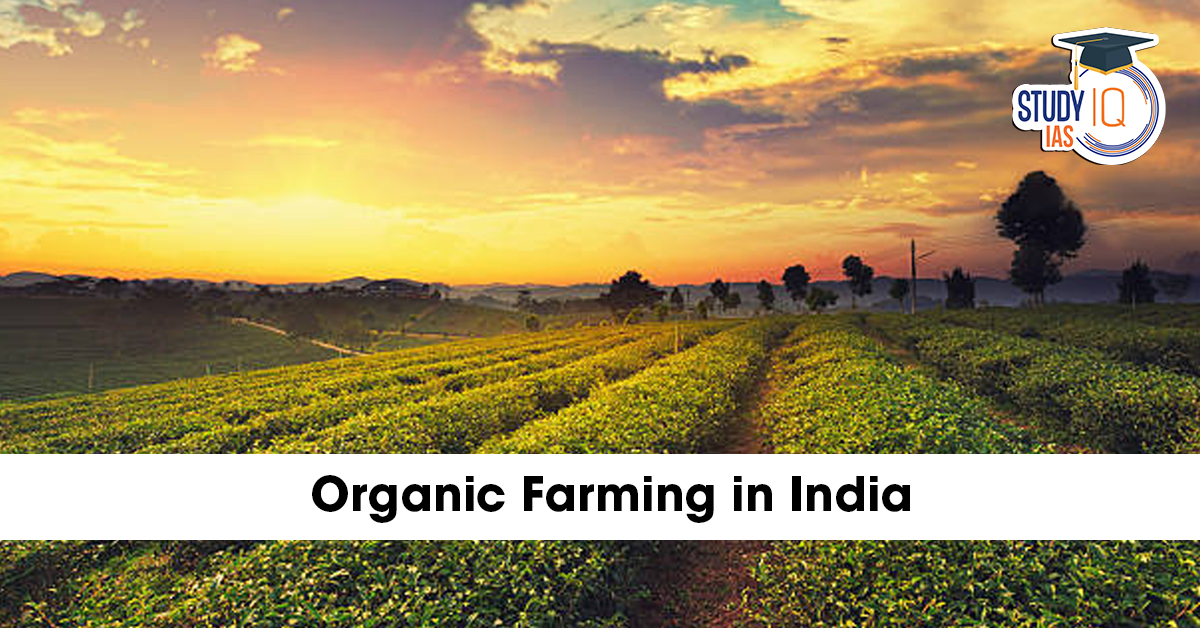Table of Contents
Context
To promote chemical-free, sustainable farming and reduce the ecological imbalance from input-intensive agriculture, the Union Government launched PKVY in 2015 under the National Mission for Sustainable Agriculture (NMSA). It has since become a flagship programme for mainstreaming organic farming and empowering rural communities.
| Current Status of Organic Farming |
Global Scenario
India’s Scenario
|
About Organic Farming
Definition
- According to FAO, “Organic agriculture is a holistic production management system which promotes and enhances agro-ecosystem health, including biodiversity, biological cycles, and soil biological activity.”
- It avoids synthetic fertilizers, pesticides, GMOs, and growth regulators, relying instead on natural inputs and biological processes.
- Core Principles:
- Health: Sustain and enhance the health of soil, plants, animals, and humans.
- Ecology: Work with natural ecosystems rather than dominating them.
- Fairness: Build equitable relationships among producers and consumers.
- Care: Manage agriculture responsibly for future generations.
- Types of Organic Farming:
- Pure Organic Farming: No use of synthetic inputs; only bio-fertilizers, green manures, compost, and natural pest control methods.
- Integrated Organic Farming: Combines crops, livestock, aquaculture, and agroforestry in a sustainable nutrient cycle.
- Natural Farming: Minimal human intervention; relies on natural processes (e.g., Zero Budget Natural Farming, Subhash Palekar’s model).
- Biodynamic Farming: Follows holistic methods using lunar cycles and natural compost preparations.
Paramparagat Krishi Vikas Yojana (PKVY)
- It was launched in 2015 under the National Mission for Sustainable Agriculture (NMSA) to revive traditional, chemical-free farming and restore ecological balance.
- Over a decade, PKVY has become a key driver of India’s organic farming revolution, blending traditional wisdom with modern systems to promote sustainability, empower farmers, and strengthen rural economies.
- Objectives:
- Promote cluster-based organic farming using traditional knowledge.
- Reduce dependence on chemical fertilizers and pesticides.
- Improve soil health, biodiversity, and productivity.
- Support certification, branding, and marketing of organic products.
- Empower farmer collectives and ensure sustainable livelihoods.
- Cluster-Based Approach: The PKVY model is built on cluster-based organic farming
- Farmers are grouped into clusters of 20 hectares to adopt organic practices collectively.
- This encourages resource sharing, peer learning, and uniform organic standards.
- So far, India has formed 52,289 clusters, covering around 15 lakh hectares, benefitting over 25.30 lakh farmers across states like Chhattisgarh, Odisha, Sikkim, Maharashtra, and Assam.
Certification Framework
Certification is the backbone of PKVY, ensuring trust and market access:
- Third-Party Certification (NPOP):
- Managed under the National Programme for Organic Production (Ministry of Commerce).
- Enables farmers to meet international organic standards for export markets.
- Covers the entire value chain – production, processing, and trade.
- Participatory Guarantee System (PGS-India):
- Community-based certification under the Ministry of Agriculture.
- Farmers collectively conduct peer verification of organic practices.
- Focused on domestic markets, low-cost and inclusive.
- Large Area Certification (LAC) (Introduced 2020–21):
- Targets regions with no history of chemical farming (tribal belts, islands).
- Reduces certification time from 2–3 years to a few months.
- Boosts export readiness and income generation in remote areas.
| Impacts of PKVY |
Limitations
|
Other Government Initiatives for Organic Farming
- Mission Organic Value Chain Development for North Eastern Region (MOVCDNER) – Focuses on organic clusters, value addition, and export infrastructure.
- National Mission on Natural Farming (NMNF) – Encourages natural and regenerative farming models.
- Bharatiya Prakritik Krishi Padhati (BPKP) – A sub-scheme of PKVY promoting traditional inputs like cow dung, jeevamrut, and mulching.
- Rashtriya Krishi Vikas Yojana (RKVY) – Provides support for organic value chain development.
- National Centre of Organic Farming (NCOF) – Coordinates organic input production and training.
- Organic e-Marketplace: Jaivik Kheti Portal – Digital platform linking organic farmers directly with buyers.
Challenges in Organic Farming in India
- Low Productivity: Organic yields are often 15–25% lower during transition periods.
- Lack of Market Infrastructure: Absence of dedicated organic markets and procurement agencies.
- Certification Complexity: Time-consuming and costly process for small farmers.
- Limited Awareness: Both farmers and consumers lack knowledge about organic standards.
- Input Constraints: Shortage of bio-fertilizers, compost, and organic seeds.
- Price Premium Uncertainty: Inconsistent market demand affects profitability.
- Logistics and Cold Chain Gaps: Poor storage and transport reduce shelf life.
- Policy Fragmentation: Overlap between schemes and lack of state coordination.
- Research Deficit: Limited R&D on organic pest management and region-specific crop systems.
- Export Bottlenecks: Complicated export certification and lack of branding in international markets.
Way Forward
- Integrated Policy Framework: Align PKVY, NMNF, MOVCDNER, and state missions under one coordinated policy.
- Market Development: Establish organic mandis, branding hubs, and MSP-like mechanisms for certified organic produce.
- Digital Certification: Simplify PGS and NPOP systems using blockchain and digital traceability.
- R&D Investment: Strengthen ICAR and SAUs to research bio-inputs, pest control, and productivity enhancement.
- Public Procurement: Include organic food in mid-day meals, hospitals, and public institutions.
- Capacity Building: Expand training for FPOs, SHGs, and local entrepreneurs in value addition and e-commerce.
- Consumer Awareness: Promote national organic branding and awareness campaigns.


 World Summit on Disaster Management (WSD...
World Summit on Disaster Management (WSD...
 Domestic Systemically Important Banks (D...
Domestic Systemically Important Banks (D...
 The Missing Link in India’s Critical M...
The Missing Link in India’s Critical M...

























